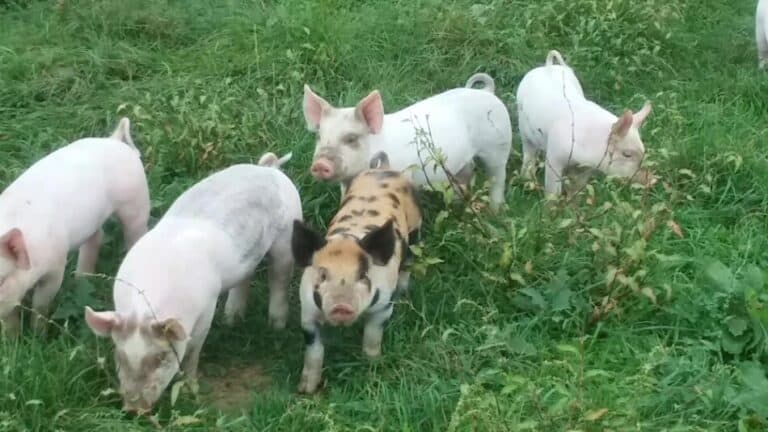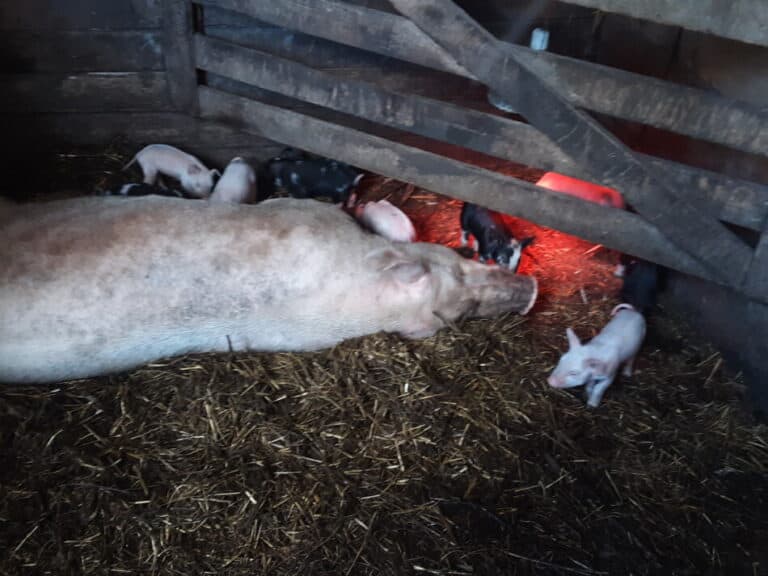Pig Raising Basics: What Do You Feed Your Pigs?
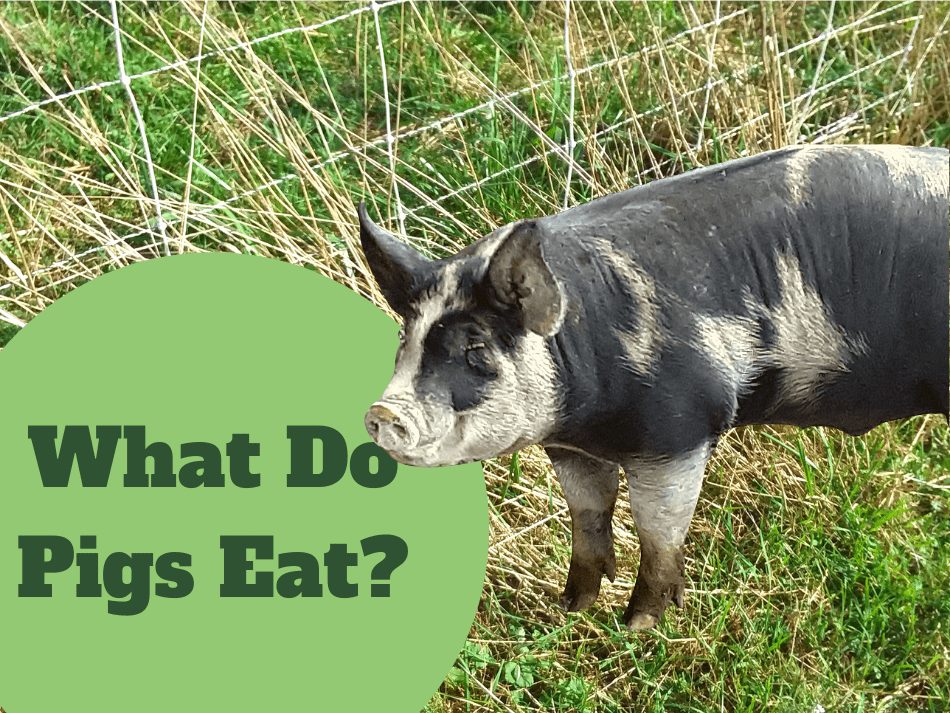
Thinking about raising some pigs for the freezer? How do you get there? What do you need to feed those little porkers now to get them growing and off to a healthy start?
Pigs need 16% ground or pelleted feed from 60-80 pounds body weight, 14% feed from 80-160 pounds body weight and 13.5% feed from 160-250+ pounds body weight.
All livestock feed, for pigs or otherwise, will be listed out by the percent protein that is in the feed. For example: 16% pig feed.
The percent of protein in the feed you need depends upon the growth stage of the pigs. The growth stage of the pigs usually listed by weight.
A common example of weight range in pigs would be: 60-80 pounds.
You don’t need to know the exact weight of your pigs, but you should have a good guess. If you are not sure, get the higher protein feed.
This way, you can be sure your pigs will have all the nutrients they need to grow well for you.
Is Raising Pigs For Meat Worth It? goes over a budget for getting, feeding and butchering the pigs to see what your costs will be to raise your own pork.
What happens if you get the wrong % feed?
Protein % too high
Feeding an overly rich feed (a higher protein than your pigs need), will just waste a bit of your money (and possibly cause the pig to have runnier than normal manure).
Higher protein feeds cost a bit more than the lower protein feeds to make, so it costs you more to buy.
Since pigs are big eaters, you’ll want to figure out the weight of your pigs soon.
The most economical way to raise a pig is to have the protein of the feed and the protein needs of the pig match.
Too high is okay for a short amount of time, not perfect, but okay and far better than too low.
Pros And Cons Of Raising Pigs goes over the good and the not so good of keeping pigs.
Protein % too low
If you do the opposite: feed too low of a protein feed, your pigs will not grow well. They can’t, you aren’t giving them the feed containing the nutrients they need to do it.
When there are nutrient deficiencies, the pig’s body has to choose essential functions, like running the immune system, over growth.
Feed your pigs right and they will quickly gain weight which will have them eating the lower protein and lower priced feeds, shortly.
Pigs need protein to grow and most importantly, to develop muscle tissue (muscles contain chiefly protein and water).
https://www.daf.qld.gov.au/business-priorities/agriculture/animals/pigs/feed-nutrition/nutrients-diets/basics
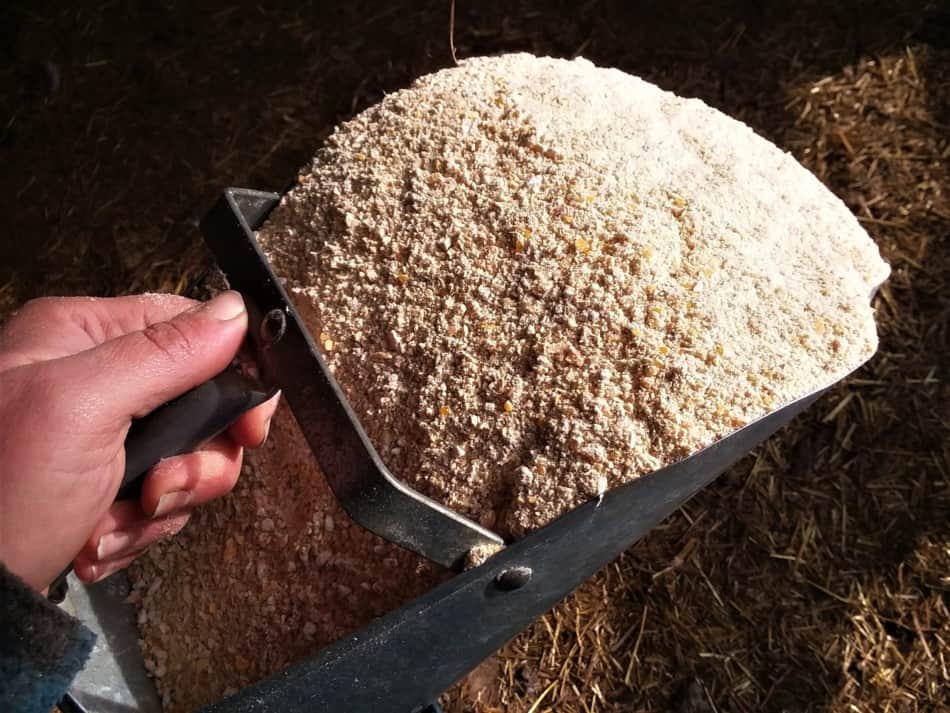
How much should you feed pigs?
You should have your pigs on full feed. Full feed means as much as they can eat, they should never run out.
Pigs can safely choose how much to eat in a day (vs other animals like sheep that will just keep stuffing in the feed until it has eaten a dangerously high amount).
Pigs will eat all that they need at the moment and then come back later for more.
If you are thinking of the phrase “pigging out” (like I was), realize pigging out refers to a pig’s enthusiasm for eating until they are full, not overeating, just eating.
You’ve got options regarding the size and weight you decide to butcher at, make sure you know them. Read my article When Is Your Pig Ready To Butcher? to help you figure it all out.
The only time when the pig’s appetite can get him into trouble is if you give unlimited access to a new food that they like more than the normal feed.
Now you may have a problem. Going “all in” with a completely new food can cause digestive problems for your pigs.
Prevent overeating of a new food by introducing any new foods to the diet slowly and in small amounts at first.
You can increase the amount of the new food as the pig’s digestive system gets used to it. Go slowly at first.
What should you not feed pigs?
The beauty of pigs is that they are omnivores, just like us. Pigs can and do eat nearly anything.
Think about a pig in the wild, it would eat bugs, berries (if it could reach them), shoots, tender plants, nuts, roots, roadkill, scavenged garbage, fallen fruit, eggs, the list goes on.
Notice I didn’t say candy, baked goods or deep frying. Pigs would not come across these type foods except for picking through the garbage of people.
Anything the pig couldn’t get without you should be left out of their diet. I have an entire article on this if you want to check it out Pig Feed Options
Here is an example: if your pig got out and ran into the garden what would it do? Eat! You’re growing some good stuff in there that both you and the pig will like.
What does this example tell you? Pigs and garden scraps go together well.
Over ripe tomatoes, turnips that a bug drilled into, greens that are now lacey with bug holes-all pig potential material.
If, on the other hand, you pig got out into your yard and started eating lollipops from the lollipop tree, that wouldn’t be good for him.
What? You don’t have a lollipop tree? That’s the point-neither does anyone else. If you can’t grow it then don’t give it to your pigs!
What is the best grain to feed pigs?
Once again, the versatility of pigs will really shine here-feed the pigs whatever grain is common in your area.
If your feed mill has a pig ration made with sorghum and that’s common in your area, go for it.
Around here, North Central Ohio, we normally use corn. Corn grows well in this area and makes the most economically priced pig feed.
Formulating pig feed out of something else can easily be done, the new feed just needs to meet the pig’s nutritional requirements for growth.
Most people would not look for out of area feed ingredients due to the cost of feeding it.
Since there would be more shipping involved and smaller amounts of the ingredients (vs. train car load size amounts most feed mills would get) the cost per pound would be high.
Can you make a complete pig ration out of nearly any feed source? Sure.
Should you? For economically priced feed, No. If you require something out of the ordinary and are willing to pay significantly more per pound for the feed, Yes.
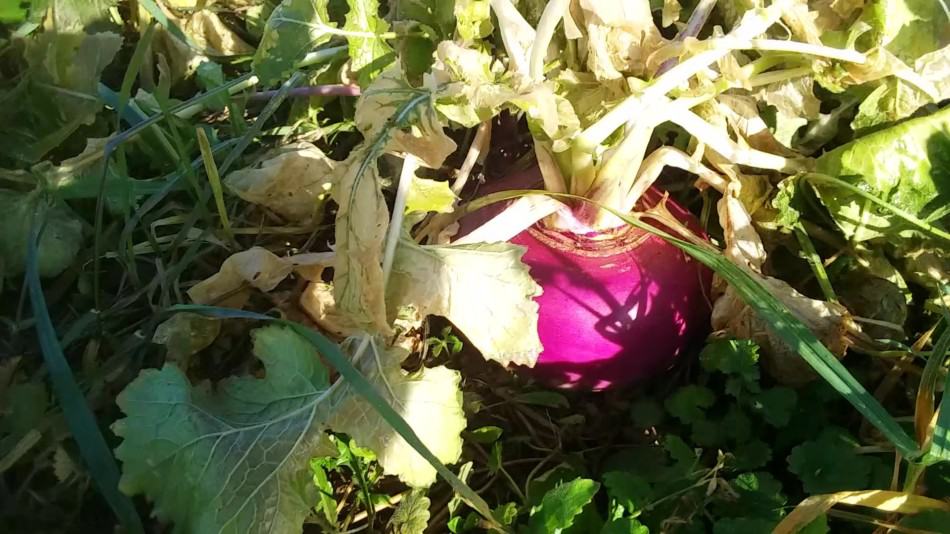
How many times a day should you feed your pigs?
We keep our pigs on full feed, unless of course I mess up and miscalculate the amount left in the feeder and we run out! Ideally, full feed the entire time they are growing.
Some people, especially folks raising show pigs, like to feed twice a day.
This way the pigs eat right in front of the owner and s/he can make sure they are growing well and on track to be at the appropriate condition and weight for the show.
If you want to hand feed (feed them twice a day) do it. There is no magic to twice a day, if you prefer a more frequent feeding schedule, do that.
Whatever you set up, do your best to stay on schedule, pigs (and their digestive systems) like routine.
Feed energy is used for maintenance and for growth and reproduction. Pigs need energy just to keep their bodily functions working. The amount of energy needed will vary according to the climate, the environment, the age and weight of the pigs, and whether they are breeding or not. For example, during cold weather, pigs use more energy keeping themselves warm. This means they must eat more if they are to keep growing as there is less energy left over for growth compared with springtime because they are using a larger portion of their feed for maintenance.
https://www.daf.qld.gov.au/business-priorities/agriculture/animals/pigs/feed-nutrition/nutrients-diets/basics
How we feed pigs
Feeder pigs/market hogs
I prefer to fill up a feeder once in a while and just check them twice daily.
Once the pigs get bigger, this will be a lot of feed to cart around, especially if there are more than two or three pigs in your care.
Adults/breeding stock
Adult pigs or pigs being kept back for breeding stock that are at 200+ pounds should not be on full feed!
Their feed must be limited or they will get overly fat and that affects their ability to function well as breeding stock.
Meaning you’ll have a really fat sow or boar that will eat like crazy but not be able to produce babies any more!
How do I make my pig grow faster?
Water availability
The best tip for helping your pigs grow faster is to make sure they always have plenty of water.
Water is the most underestimated part of your pig’s feeding ration.
I know this isn’t a snazzy, attention getting tip, it’s an obvious tip. Honestly, though, that’s why it is so important.
So many people overlook the obvious, trying to find an exotic problem. Pigs need plentiful water. It’s easy to do but also easy to overlook.
Pigs should be comfortable
Make sure the pigs are comfortable. Do they have enough space to zoom around and satisfy their curiosity?
Can they maintain comfortable body temperature? Meaning if it’s hot, they need to get somewhere cool and if they are cold, they need a well bedded spot to lay in together.
Feed the correct ration
Keep the protein percentage appropriate for the age and size of the pig. Younger pigs need more protein per pound of feed than bigger/older pigs.
Don’t cheap out here! Inadequate protein levels will negatively impact the growth of your pigs.
I have an complete article on How Fast Do Pigs Grow here.
Can pigs live on grass alone?
Most pigs can’t grow well on grass alone. Pigs can eat grass, but they can not get the nutrients, specifically calories, from grass alone to support their growth.
Pigs have a stomach like yours. If pigs had a ruminant stomach like a cow or sheep, they could live on grass alone.
The calories that are available in grass are locked in the fiber. A digestive system that ferments the fiber (like a ruminant’s) will release the calories by breaking down the fiber into digestible parts.
Once the fiber is broken down into digestible parts, the cow is now able to use these previously unavailable calories for growth.
A digestive system like a pig’s, can not break down the fiber. In a pig, and us, the fiber passes through the digestive system without being digested.
It ends up as a bulking agent in the poop. That’s certainly important, but doesn’t provide calories.
That doesn’t make sense, you said pigs can’t live on grass!
Confused, yet? Depending upon which article you can across on the internet, I may have surprised you here. I’m guessing you had one of two reactions:
- Maybe you’ve heard of farmers who raise pastured pork? Why would anyone do that? Pastured pork probably doesn’t make a whole lot of sense now, after that whole pigs can’t live on grass thing.
- Or you think I have no idea what I’m talking about, since a simple internet search will show you many people with pigs on grass.
Let’s get this question cleared up.
Starting here (the part most people leave out)-pigs can eat grass, for the vast majority of pigs, they can’t live on it exclusively, they must have more calories.
To be upfront, there are a few folks raising pigs that do not need any grain or supplemental feeds, Sugar Mountain Farm is one. How can they do this? Years and years of selection and culling.
If your pigs are not selected for grass only, they need feed. Plus, when you are new to pigs, using feed just makes it easier to be sure your pigs are getting what they need nutritionally.
Pasture based pig raisers put the feeder out in the pasture with the pigs. In this situation the pigs can choose when to eat feed or when to roam around looking for grass, roots or bugs.
The few pasture based pig raisers that are not feeding grain will have other high calorie foods, like root vegetables, that the pigs are eating along with the grass.
The grain part isn’t the key here, it’s the higher calorie feed available along with the grass. Where the calories come from doesn’t matter as long as they are available to the pig.
Simply said-Can pigs eat grass? Yes. Can pigs grow well on grass alone? No.
How much does it cost to raise a pig?
The cost of raising a pig depends completely upon the cost per pound of the feed you are using.
The pig needs to eat three pounds of feed to gain one pound of weight. Now we’ll get into some math to get a few cost estimates.
Step 1: What size feeder pig do you have?
We’ll start with a 60 pound feeder pig and are headed for a finishing weight of 260 pounds.
Step 2: Determine the pounds of gain
That means you need to subtract the feeder pig weight from the finishing weight to get the total pounds of gain you’ll need for your pigs.
In this example, your pig needs to gain 200 pounds to reach butchering size.
260 pound finishing weight-60 pound feeder pig=200 pounds of gain needed
Step 3: Use the 3 to 1 gain ratio
Now, we are going to multiply the pounds of gain needed (from Step 2) by the feed amount needed to gain that pound of body weight.
Remembering to use the 3 to 1 gain ratio, we get a total of 600 pounds of feed per pig.
200 pounds of gain x 3 pounds of feed/pound of gain=600 pounds of feed total per pig to grow them from feeder size to butchering size
On to the cost of the feed
This is where you’ll need to use your own numbers.
We’ll go through two versions of feed costs to give you an idea of what you are likely to see when you run your own numbers on feed costs.
Feed cost example 1
Feed cost: $0.36/pound
Feed source: local farm store in 50 pound bags at $18.00/bag
$0.36 x 600=$216.00
Total feed cost=$216.00 per pig
Feed cost example 2
Feed cost: $0.14/pound
Feed source: local feed mill in 100 pound bags averaging $14.00/bag
$0.14 x 600=$84.00
Total feed cost=$84.00 per pig
Important points to remember regarding feed costs
- Buying feed in the smaller bags, 50 pound size, will always cost more than buying in bulk
- Bulk feed, 100 pound bags, are only available at mills that grind their own feed (a store that only has 50 pound bags is not grinding their own feed)
- Only get the amount of feed that your pig will eat within 2-2.5 weeks. As soon as feed is ground, it begins losing nutritional value. Use fresh.
- If you buy a smaller feeder pig to start with, you’ll need more feed to get your pig to finishing weight.
Other costs for raising a pig
You’ll want to figure in a few other costs as well, like feeders, waterers and bedding. If you need to build a pen or put up a fence, remember those costs, as well.
The good news here is that most of these items, except the bedding!, can be reused for many more batches of pigs.
We have a feeder that we have been using for 20+ years! (It has a few dents, but still works great!)
Since this equipment is manufactured for pigs, it is made tough to begin with. Otherwise the pigs would tear it up.
If you would rather not spend the money now on equipment, consider rubber feed pans.
I love these things! They can be used for feed or water and last forever.
You will need to spend more time with the pigs filling the pans, but if you’re willing to do the work, try it.
Once you decide to get more pigs, or raise more at a time you’ll want to find some hog specific equipment, but for just starting out, you can be creative.
Word to the wise-pigs are the masters at spilling water.
If you can’t have water spilled where you have your pigs, rethink the pan-you need an actual waterer.
A waterer won’t be perfect, they’ll still do their best to play in the drips. It’ll just be less messy (if you are a pig, you call this fun!) than if they can dive right in, like when using the rubber pan.

